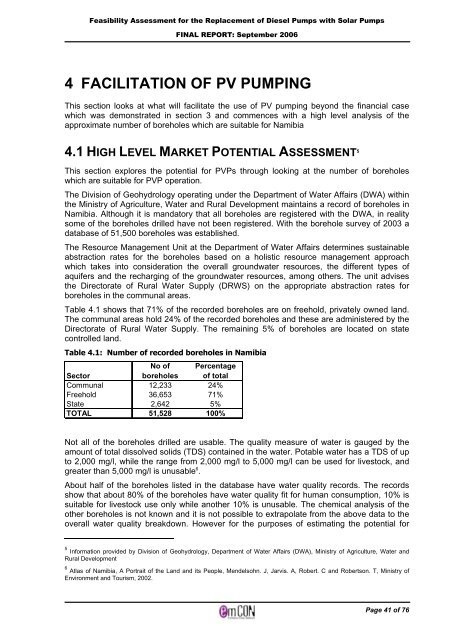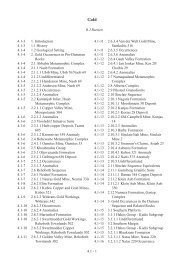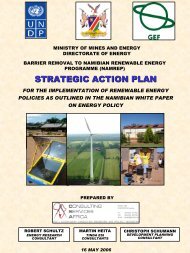Solar PV water pumping study - FINAL REPORT ... - UNDP, Namibia
Solar PV water pumping study - FINAL REPORT ... - UNDP, Namibia
Solar PV water pumping study - FINAL REPORT ... - UNDP, Namibia
Create successful ePaper yourself
Turn your PDF publications into a flip-book with our unique Google optimized e-Paper software.
Feasibility Assessment for the Replacement of Diesel Pumps with <strong>Solar</strong> Pumps<br />
<strong>FINAL</strong> <strong>REPORT</strong>: September 2006<br />
4 FACILITATION OF <strong>PV</strong> PUMPING<br />
This section looks at what will facilitate the use of <strong>PV</strong> <strong>pumping</strong> beyond the financial case<br />
which was demonstrated in section 3 and commences with a high level analysis of the<br />
approximate number of boreholes which are suitable for <strong>Namibia</strong><br />
4.1 HIGH LEVEL MARKET POTENTIAL ASSESSMENT 5<br />
This section explores the potential for <strong>PV</strong>Ps through looking at the number of boreholes<br />
which are suitable for <strong>PV</strong>P operation.<br />
The Division of Geohydrology operating under the Department of Water Affairs (DWA) within<br />
the Ministry of Agriculture, Water and Rural Development maintains a record of boreholes in<br />
<strong>Namibia</strong>. Although it is mandatory that all boreholes are registered with the DWA, in reality<br />
some of the boreholes drilled have not been registered. With the borehole survey of 2003 a<br />
database of 51,500 boreholes was established.<br />
The Resource Management Unit at the Department of Water Affairs determines sustainable<br />
abstraction rates for the boreholes based on a holistic resource management approach<br />
which takes into consideration the overall ground<strong>water</strong> resources, the different types of<br />
aquifers and the recharging of the ground<strong>water</strong> resources, among others. The unit advises<br />
the Directorate of Rural Water Supply (DRWS) on the appropriate abstraction rates for<br />
boreholes in the communal areas.<br />
Table 4.1 shows that 71% of the recorded boreholes are on freehold, privately owned land.<br />
The communal areas hold 24% of the recorded boreholes and these are administered by the<br />
Directorate of Rural Water Supply. The remaining 5% of boreholes are located on state<br />
controlled land.<br />
Table 4.1: Number of recorded boreholes in <strong>Namibia</strong><br />
No of Percentage<br />
Sector<br />
boreholes of total<br />
Communal 12,233 24%<br />
Freehold 36,653 71%<br />
State 2,642 5%<br />
TOTAL 51,528 100%<br />
Not all of the boreholes drilled are usable. The quality measure of <strong>water</strong> is gauged by the<br />
amount of total dissolved solids (TDS) contained in the <strong>water</strong>. Potable <strong>water</strong> has a TDS of up<br />
to 2,000 mg/l, while the range from 2,000 mg/l to 5,000 mg/l can be used for livestock, and<br />
greater than 5,000 mg/l is unusable 6 .<br />
About half of the boreholes listed in the database have <strong>water</strong> quality records. The records<br />
show that about 80% of the boreholes have <strong>water</strong> quality fit for human consumption, 10% is<br />
suitable for livestock use only while another 10% is unusable. The chemical analysis of the<br />
other boreholes is not known and it is not possible to extrapolate from the above data to the<br />
overall <strong>water</strong> quality breakdown. However for the purposes of estimating the potential for<br />
5 Information provided by Division of Geohydrology, Department of Water Affairs (DWA), Ministry of Agriculture, Water and<br />
Rural Development<br />
6 Atlas of <strong>Namibia</strong>, A Portrait of the Land and its People, Mendelsohn. J, Jarvis. A, Robert. C and Robertson. T, Ministry of<br />
Environment and Tourism, 2002.<br />
Page 41 of 76




